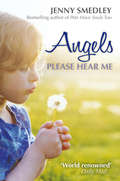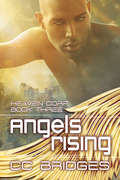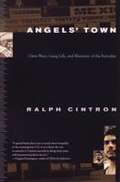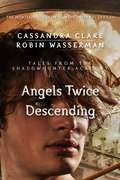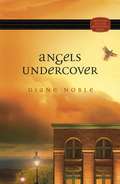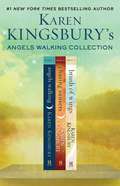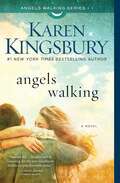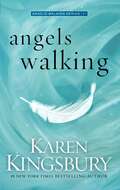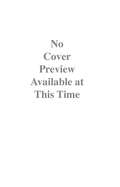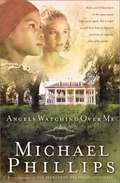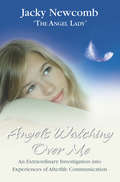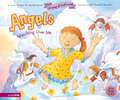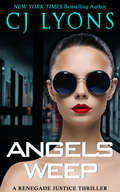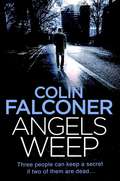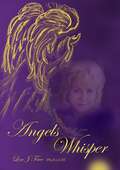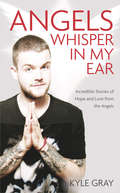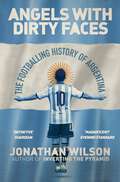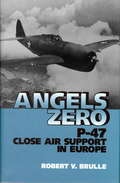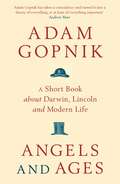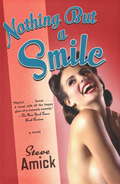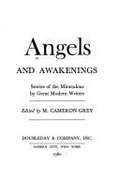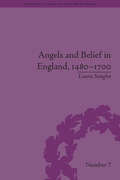- Table View
- List View
Angels Please Hear Me
by Jenny SmedleyDo you believe in angels, but wonder why yours never seems to hear you?Are you tired of watching others leading lives full of joy, while you have to struggle through each day?Do you long to win the lottery so that you can change your life, but always end up disappointed?If that describes you, then don’t panic – help is at hand. Let Jenny show you how you may be generating the wrong kind of energy to get angelic assistance, and how to change things so that you can finally get the help you long for. If you love angels, love reading about other peoples’ experiences with them, and would like to know how to have better communication with yours, Angels Please Hear Me is the book you need.
Angels Rising (Heaven Corp #3)
by Cc BridgesHeaven Corp: Book ThreeBetter to reign in hell…. Uriel 3019 has been a cybernetically altered angel since he volunteered for the program fifteen years ago. His devotion to the floating city of Heaven is fierce, and he’ll follow any command he’s given. But Uriel’s orderly world is crumbling. Angels are going mad, even hurting people. Some are rebelling, and the noble families are vying for control—by any means necessary. Uriel’s latest assignment brings him into a secret society, where his partner, Raphael, is working for freedom and equality for all angels. Could their group be responsible for the angels’ recent erratic behavior? Uriel is determined to find out—and report on his findings. But he doesn’t count on Raphael’s confession—that he has feelings for Uriel—or the memories slowly starting to return from the time before he became an angel. Is he on the right side? Does he dare to stand against Heaven, even if doing so will save his fellow angels from becoming soulless automatons? Uriel has to decide if his loyalty belongs to his superiors… or to the angel who’s stolen his heart.
Angels Town: Chero Ways, Gang Life, and the Rhetorics of Everyday
by Ralph CintronAs issues of power and social order loom large in Angelstown, Ralph Cintron shows how eruptions on the margins of the community are emblematic of a deeper disorder. In their language and images, the members of a Latino community in a midsized American city create self-respect under conditions of disrespect. Cintron's innovative ethnography offers a beautiful portrait of a struggling Mexican-American community and shows how people (including ethnographers) make sense of their lives through cultural forms.
Angels Twice Descending (Tales from the Shadowhunter Academy #10)
by Robin Wasserman Cassandra ClareSimon's journey to become a Shadowhunter nears its end as his Ascension ceremony draws closer. One of ten adventures in Tales from the Shadowhunter Academy.Simon's Ascension ceremony draws near in this brilliant conclusion to Tales from the Shadowhunter Academy. This standalone e-only short story follows the adventures of Simon Lewis, star of the #1 New York Times bestselling series, The Mortal Instruments, as he trains to become a Shadowhunter. Tales from the Shadowhunter Academy features characters from Cassandra Clare's Mortal Instruments, Infernal Devices, and the upcoming Dark Artifices and Last Hours series. Angels Twice Descending is written by Cassandra Clare and Robin Wasserman. Read more of Cassandra Clare's Shadowhunter Chronicles in The Infernal Devices, The Mortal Instruments, and The Bane Chronicles.
Angels Undercover (Mystery and the Minister's Wife #6)
by Diane NobleEscape to the charming town of Copper Mill, Tennessee. Nestled in the foothills of the Great Smoky Mountains, Copper Mill is a place of tradition and tranquillity. But when Kate Hanlon and her husband Paul move in, they discover that small town life is anything but boring. The mysteries Kate uncovers are puzzling, but she always uses her quick mind and the help of her dear friends to figure out the answer. See how faith can solve life's mysteries in the Mystery and the Minister's Wife series. When a valuable Confederate uniform disappears from a special display at the library, Kate Hanlon has another mystery on her hands in Angels Undercover. History comes alive in Copper Mill when a group of Civil War re-enactors come to town. But when valuable historical memorabilia belonging to Caroline Johnston's grandfather, a Confederate hero, disappears from a display at the Copper Mill library, Kate vows to help the broken-hearted widow find answers. A series of break-ins around town raise fears, but not all the burglaries are as sinister as they appear. A mysterious note, a suspicious request, and a long-buried secret lead Kate on a roundabout search for the truth. Meanwhile, a debate about worship music may just tear Faith Briar Church apart. With some members ready to split, can Paul hold this fractured church together? As they struggle to keep peace in their community, Kate and Paul realise that sometimes God sends angels where you least expect them.
Angels Walking Box Set: Angels Walking, Chasing Sunsets, and Brush of Wings (Angels Walking Ser. #1)
by Karen KingsburyKaren Kingsbury’s compelling New York Times bestselling Angels Walking series is available for the first time as one complete boxed set.In Angels Walking, former baseball star Tyler Ames suffers a career-ending injury. As he tries to put his life back together the way it was before, he discovers the devastating news that his one true love, Sami Dawson, has moved on. When a small series of miracles leads Tyler to form a friendship with Virginia Hutcheson, an elderly woman with Alzheimer’s, he realizes that she might have the answers he so desperately seeks. Can a team of Angels Walking restore hope and bring healing for Tyler, Sami, and Virginia? And can the words of a stranger rekindle lost love? Growing up in a comfortable home, Mary Catherine, in Chasing Sunsets, never yearned for an extravagant lifestyle the way her parents did. Instead, she pursues meaning through charity work, giving away a part of herself but never giving away her heart. But she finds herself drawn to LA Dodger Marcus Dillinger when she volunteers with her roommate Sami at a local youth center, and she discovers an exciting life she never dreamed of. That is, until she receives devastating news from her doctor that alters her future and forces her to make a rash decision. Finally, in Brush of Wings, Mary Catherine moves to Uganda to work at an orphanage against the advice of her doctor. She may not have long to live, but she chooses to help others with the time she has left. The only problem is Marcus, the man she never meant to fall in love with. He knows something is wrong, and after months of silence from Mary Catherine, a divinely timed letter leads him on a desperate life-or-death mission. Then his friends receive shocking news that changes everyone’s plans. The angels in their midst are doing everything they can to make sure their mission succeeds.
Angels Walking: A Novel (Angels Walking #1)
by Karen KingsburyFrom #1 New York Times bestselling author Karen Kingsbury comes the first in a brand-new series about second chances—a dramatic story about a washed up baseball player, the love he left behind, and the miracles that might save them both.When former national baseball star Tyler Ames suffers a career-ending injury, all he can think about is putting his life back together the way it was before. He has lost everyone he loves on his way to the big leagues. Then just when things seem to be turning around, Tyler hits rock bottom. Across the country, Tyler’s one true love Sami Dawson has moved on. A series of small miracles leads Tyler to a maintenance job at a retirement home and a friendship with Virginia Hutcheson, an old woman with Alzheimer’s who strangely might have the answers he so desperately seeks. A team of Angels Walking take on the mission to restore hope for Tyler, Sami, and Virginia. Can such small and seemingly insignificant actions of the unseen bring healing and redemption? And can the words of a stranger rekindle lost love? Every journey begins with a step. It is time for the mission to begin…
Angels Walking: A Novel (Angels Walking Ser. #No. 1)
by Karen KingsburyThe new inspirational novel from the New York Times No 1 bestseller, for fans of Mitch Albom and Francine Rivers.One-time national baseball hero Tyler Ames has lost everyone he loves on a quest to make it to the big league. Then, just when things seem to be turning around, Tyler hits rock bottom as he discovers that, across the country, his only love Sami Dawson has moved on. A series of small miracles leads Tyler to a maintenance job at a retirement home and a friendship with Virginia Hutcheson, an elderly woman with Alzheimer's, who strangely might have the answers he so desperately seeks.Somewhere in heaven, a decision has been made. An Angels Walking team has been assigned to see hope restored for Tyler, Sami, and Virginia. When angels walk, most people never know, never see. But they are there. And sometimes the stakes are so high, all of heaven stands ready. of a stranger rekindle lost love? Every journey begins with a step. It is time for the mission to begin...
Angels Watching Over Me
by Lurlene McdanielHappy Holidays! Bah humbug. "Happy" is not the way Leah Lewis-Hall would describe herself at the moment. She's spending her twelve days of Christmas in an Indianapolis hospital, while her mother is thousands of miles away on a honeymoon with husband number five. Leah went to the doctor with nothing morethan a broken finger, but he ordered her to undergo some tests. Now she's stuck in the hospital, alone. Then Leah meets her hospital roommate, a young Amish girl named Rebekah, and her big family. Cynical sixteen-year-old Leah has never known people like this before. From Rebekah's handsome brother, Ethan, who can barely look Leah in the eye, to her kind older sister, Charity, the Amish family captivates Leah with its simple, loving ways. When Leah receives frightening information about her condition, her new friends show her that miracles can happen. And that sometimes angels appear in the most unexpected places.From the Paperback edition.
Angels Watching Over Me (Miracles and Mysteries of Mercy Hospital #3)
by Gabrielle MeyerWhen a car accident victim is brought to Mercy Hospital, Evelyn is charged with safeguarding the unconscious woman's belongings. Among the patient's items is a beautiful ruby and diamond ring with a unique inscription. Evelyn discovers the ring is one of eight that were given to the Lords Proprietors of Carolina in 1663 by King Charles II--and is the only one that has not been purchased by one of the king's descendants. As soon as the woman wakes up, Evelyn assures her that her belongings, including the valuable ring, are safe. But the woman apparently has no idea what ring she's talking about. In fact, the woman has no recollection of the day of the accident After someone breaks into the records room and leaves a threatening note, Evelyn and her friends are determined to help the woman regain her memory. Can they uncover the truth behind the ring before more trouble heads their way? Four talented women from very different walks of life witness the miracles happening around them at Mercy Hospital and soon become fast friends. Join Joy Atkins, Evelyn Perry, Anne Mabry, and Shirley Bashore as, together, they solve the puzzling mysteries that arise at this Charleston, South Carolina, historic hospital--rumored to be under the protection of a guardian angel. Come along as our quartet of faithful friends solve mysteries, stumble upon a few of the hospital's hidden and forgotten passageways, and discover historical treasures along the way! This fast-paced series is filled with inspiration, adventure, mystery, delightful humor, and loads of Southern charm! When a car accident victim is brought to Mercy Hospital, Evelyn is charged with safeguarding the unconscious woman's belongings. Among the patient's items is a beautiful ruby and diamond ring with a unique inscription. Evelyn discovers the ring is one of eight that were given to the Lords Proprietors of Carolina in 1663 by King Charles Il--and is the only one that has not been purchased by one of the king's descendants. As soon as the woman wakes up, Evelyn assures her that her belongings, including the valuable ring, are safe. But the woman apparently has no idea what ring she's talking about. In fact, the woman has no recollection of the day of the accident After someone breaks into the records room and leaves a threatening note, Evelyn and her friends are determined to help the woman regain her memory. Can they uncover the truth behind the ring before more trouble heads their way? Four talented women from very different walks of life witness the miracles happening around them at Mercy Hospital and soon become fast friends. Join Joy Atkins, Evelyn Perry, Anne Mabry, and Shirley Bashore as, together, they solve the puzzling mysteries that arise at this Charleston, South Carolina, historic hospital--rumored to be under the protection of a guardian angel. Come along as our quartet of faithful friends solve mysteries, stumble upon a few of the hospital's hidden and forgotten passageways, and discover historical treasures along the way! This fast-paced series is filled with inspiration, adventure, mystery, delightful humor, and loads of Southern charm!
Angels Watching Over Me (Shenandoah Sisters, Book #1)
by Michael PhillipsKatie and I'd been born in the same country only a year apart, but might have been in different centuries on opposites sides of the world.
Angels Watching Over Me: An Extraordinary Investigation Into Experiences Of Afterlife Communication
by Jacky NewcombThe souls of our loved ones take a keen interest in our lives here on earth. Angels Watching Over Me offers a glimpse into the magical stories of communication between our world and the next. These messages will bring comfort and healing to anyone who has lost someone close to them, whether recently or long ago. In this book, Jacky Newcomb illustrates the power of real-life spontaneous afterlife experiences and how they show that life goes on after we leave the physical realm. These stories have much in common with the classic angel experience, and show that the souls of your loved ones watch over you as you live your life.
Angels Watching over Me (A Song of God's Love)
by Lynn Hodges Sue BuchananFrom the co creators of the bestseller I Love You This Much comes another touching lullaby book. Join a little one as she wonders about God's promise to send angels to protect us. Are angels big or small? Do they really have wings? Will they come when we call? Sing along as your child drifts off to sleep surrounded by angels and loved by God.
Angels Weep: A Renegade Justice Thriller Featuring Morgan Ames (Renegade Justice Thrillers #3)
by CJ LyonsA serial killer’s daughter uncovers a disturbingly familiar pattern of murder in the New York Times bestselling author’s medical thriller.Morgan Ames never expected to survive when she threw herself and her serial killer father off a cliff. She was fine with that—as long as it stopped his killing spree. But after waking up from a coma, she finds herself in a nightmare worse than her father’s sadistic tortures: she’s trapped in the Pediatric unit at Angels of Hope Rehab Center. Since the authorities know Morgan is only fifteen, she’s been made a ward of the hospital until the legal system figures out what to do with her. Fighting for her freedom should be her first priority. But her father wasn’t the only serial killer on the loose. Someone is preying on the innocent children of Angels and their families. And only Morgan has what it takes to put a stop to it . . . even if it means sacrificing her own second chance at life.
Angels Weep: A twisted and gripping authentic London crime thriller from the bestselling author
by Colin Falconer'Dripping with authenticity. Packed full of characters you genuinely care about . . . I didn't read the last few chapters, I devoured them. An absolute triumph' M. W. CRAVEN_____________________Three can keep a secret. If two of you are dead...Two women are snatched off the streets of London in one weekend.DI Charlie George and his team get to work. The lives of these young women - one of them a mother - are on the line, and the clock is ticking.When they catch a lucky break from a CCTV camera, Charlie is sure they have their man. And that's when he gets his first surprise. Because nothing about this case is simple and not everyone is quite what they seem.Charlie's job is to find the missing women and get to the truth. But some people would rather the truth stays hidden - even when the bodies start to pile up..._____________________Praise for Colin Falconer'Once you read [a] Colin Falconer [book], you'll want to read everything he's ever written' Crystal Book Reviews'Falconer's grasp of period and places is almost flawless ... He's my kind of writer' Peter Corris, The Australian'You are in for a real roller-coaster ride of never ending intrigue'History and Women'Falconer demonstrates exceptional characterization' Bookgeeks
Angels Weep: A twisted and gripping authentic London crime thriller from the bestselling author (Charlie George #3)
by Colin Falconer'Dripping with authenticity. Packed full of characters you genuinely care about . . . I didn't read the last few chapters, I devoured them. An absolute triumph' M. W. CRAVEN_____________________Three can keep a secret. If two of you are dead... Two women are snatched off the streets of London in one weekend.DI Charlie George and his team get to work. The lives of these young women - one of them a mother - are on the line, and the clock is ticking.When they catch a lucky break from a CCTV camera, Charlie is sure they have their man. And that's when he gets his first surprise. Because nothing about this case is simple and not everyone is quite what they seem.Charlie's job is to find the missing women and get to the truth. But some people would rather the truth stays hidden - even when the bodies start to pile up..._____________________Praise for Colin Falconer'Once you read [a] Colin Falconer [book], you'll want to read everything he's ever written' Crystal Book Reviews'Falconer's grasp of period and places is almost flawless ... He's my kind of writer' Peter Corris, The Australian'You are in for a real roller-coaster ride of never ending intrigue'History and Women'Falconer demonstrates exceptional characterization' Bookgeeks
Angels Weep: A twisted and gripping authentic London crime thriller from the bestselling author (Charlie George #3)
by Colin Falconer'Dripping with authenticity. Packed full of characters you genuinely care about . . . I didn't read the last few chapters, I devoured them. An absolute triumph' M. W. CRAVEN_____________________Three can keep a secret. If two of them are dead... Two women are snatched off the streets of London in one weekend.DI Charlie George and his team get to work. The lives of these young women - one of them a mother - are on the line, and the clock is ticking.When they catch a lucky break from a CCTV camera, Charlie is sure they have their man. And that's when he gets his first surprise. Because nothing about this case is simple and not everyone is quite what they seem.Charlie's job is to find the missing women and get to the truth. But some people would rather the truth stays hidden - even when the bodies start to pile up..._____________________Praise for Colin Falconer'A compelling piece of crime fiction . . . An entertaining and gritty read' 4 stars, Netgalley reader'This one doesn't disappoint!' 5 stars, Netgalley reader'It held my attention from start to finish . . . I have no hesitation in recommending' 4 stars, Netgalley reader'Once you read [a] Colin Falconer [book], you'll want to read everything he's ever written' Crystal Book Reviews'Falconer's grasp of period and places is almost flawless ... He's my kind of writer' Peter Corris, The Australian'You are in for a real roller-coaster ride of never ending intrigue'History and Women'Falconer demonstrates exceptional characterization' Bookgeeks
Angels Whisper
by Lou J. FreeLou J Free wrote this how-to book for you to honor your angels and put the 'natural' into the supernatural. Lou J interweaves fascinating real life stories and examples with clear explanations of the rules of the road. You are not alone. A vast and glorious world of departed loved ones and guiding spirits are eager to take you by the hand. Shelley Stockwell, Ph.D. The publisher of this book donated a digital copy to Bookshare.org. Join us in thanking Spirit Press for providing this accessible digital book to this community.
Angels Whisper in My Ear: Incredible Stories of Hope and Love from the Angels
by Kyle GrayFrom the age of four, Angel Whisperer Kyle Gray has been blessed by the presence of angels. They stood alongside him as he developed his talents to become the UK's youngest professional psychic medium at the age of sixteen. In this book, Kyle takes the reader on an emotional and uplifting journey into the world of angels. He reveals his own beautiful and inspiring story of learning to communicate with the other side, which started when his beloved grandmother passed over. This communication was to become his vocation and purpose, and Kyle is now known for the startling accuracy of his readings. Drawing on his years of experience helping people to share the wisdom and messages of the angels, Angels Whisper in My Ear teaches you ways in which you too can make your own connections, change your ways of thinking and finally achieve everything you have ever dreamed of. An intensely personal and moving book, it offers comfort, wisdom and practical advice that will help transform your life.
Angels With Dirty Faces: The Footballing History of Argentina
by Jonathan Wilson'ABSORBING' Guardian'ENTHRALLING' New Statesman'EPIC' Evening Standard'INESCAPABLE' The Sunday Times'MAGISTERIAL' Irish ExaminerFully revised and updated, the definitive history of Argentinian football from the award-winning author of Inverting the PyramidAlfredo Di Stefano, Diego Maradona, Gabriel Batistua, Juan Roman Riquelme, Lionel Messi... Argentina has produced some of the greatest footballers of all time. But the rich, volatile history of Argentinian football is made up of both the sublime and the ruthlessly pragmatic. Jonathan Wilson, having lived in Buenos Aires, is ideally placed to chart the sport's development in a country that, perhaps more than any other, lives and breathes football, its theories and its myths.Fully revised and updated, this new edition looks at the contrasting evolution of Argentinian football over the last ten years; from the chaos and violence of the abandoned 2018 Copa Libertadores final between River Plate and Boca Juniors to the revitalised national side under manager Lionel Scaloni, which triumphed at the 2019 Copa América and the 2022 World Cup.ANGELS WITH DIRTY FACES is the definitive history of a great footballing nation and its many paradoxes.Update Publishing: 07.12.23
Angels Zero
by Robert BrulleRobert V. Brulle, who flew seventy ground support missions with the 366th Fighter Group, links his daily experiences in the cockpit not only with the battles in which he participated but also with events in the wider European theater. Combining anecdotes from his personal diary, research in US and German records, and interviews with participants from both sides, Brulle details a combat career that began just after D-Day, when he flew column cover for Allied troops as they chased the German military out of France. He then describes the brutal, six-week Hürtgen Forest campaign, during which his fighter group lost 15 pilots and 18 aircraft. He also tells how the otherwise bitterly fought Battle of the Bulge provided the 366th with an opportunity to successfully engage 60 Luftwaffe airplanes in a dogfight directly over their airfield.Angels Zero combines both personal and historical detail to vividly re-create a lesser-known aspect of the air war in Europe.
Angels and Ages: A short book about Darwin, Lincoln and modern life
by Adam Gopnik'Adam Gopnik has taken a coincidence and turned it into a theory of everything, or at least of everything important ... Outstanding' - Andrew MarrOn February 12th, 1809, two men were born an ocean apart: Abraham Lincoln in a one-room Kentucky log cabin; Charles Darwin on an English country estate. Each would see his life's work transform mankind's understanding of itself. In this bicentennial twin portrait, Adam Gopnik shows how these two giants, who never met, changed the way we think about the very nature of existence, and that their great achievements proceeded from the same source: argument from reason. The revolutions they effected shaped the world we live in, while the intellectual heritage and method that informed their parallel lives has profound implications for our present age. Filled with little-known stories and unfamiliar characters, Angels and Ages reveals these men in a new, shared light, and provides a fascinating insight into the origins of our modern vision and liberal values.
Angels and Ages: Lincoln, Darwin, and the Birth of the Modern Age
by Adam GopnikIn this captivating double life, Adam Gopnik searches for the men behind the icons of emancipation and evolution. Born by cosmic coincidence on the same day in 1809 and separated by an ocean, Lincoln and Darwin coauthored our sense of history and our understanding of man's place in the world. Here Gopnik reveals these two men as they really were: family men and social climbers, ambitious manipulators and courageous adventurers, grieving parents and brilliant scholars. Above all we see them as thinkers and writers, making and witnessing the great changes in thought that mark truly modern times.
Angels and Awakenings: Stories of the Miraculous
by M. Cameron GreyThis is a collection of short stories by nineteenth- and twentieth-century authors, all dealing with miracles or miraculous interventions. The sweeping range of selections interprets the miraculous in the broadest sense. Conrad Aiken's "Mr. Arcularis" has the macabre flavor of a work by Edgar Allan Poe; Mark Twain's "The Story of a Good Little Boy" and John Steinbeck's "Saint Katy the Virgin" are filled with ironic humor; Flannery O'Cponnor's "Revelation" reveals the agony of a self-satisfied woman suddenly confronted with her own failings; and William Hoffman's "The Question of Rain" deals with a small-town minister who must put his faith to the test.
Angels and Belief in England, 1480–1700 (Religious Cultures in the Early Modern World #7)
by Laura SanghaThis study looks at the way the Church utilized the belief in angels to enforce new and evolving doctrine.Angels were used by clergymen of all denominations to support their particular dogma. Sangha examines these various stances and applies the role of angel-belief further, to issues of wider cultural and political significance.
